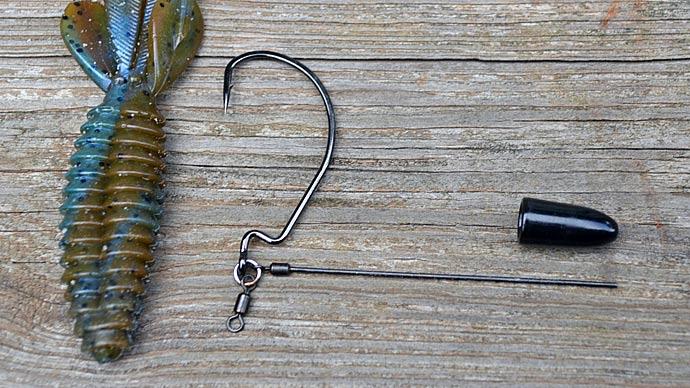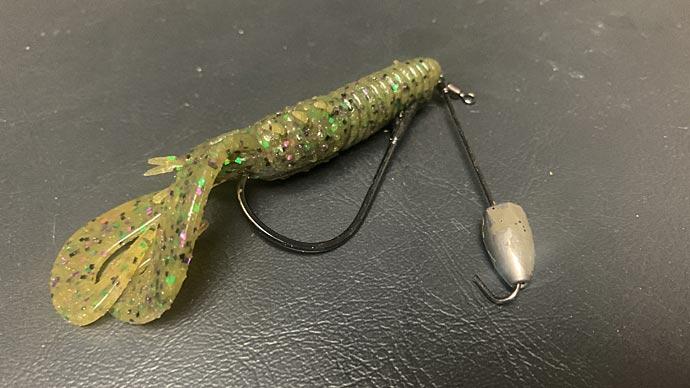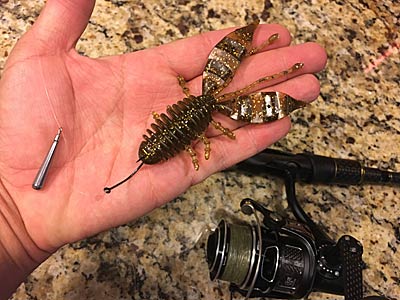
The Free Rig? What is that? Berkley/Abu Garcia pro-staffer Daniel Elias heard about this rig five or six months ago from Japanese anglers he follows on Instagram. “Their posts aren’t even in English,” Daniel says, so all he could do was look at the photos and go from there. The Free Rig uses a cylindrical weight like a drop shot or Mojo weight, but instead of a clip or a tunnel, the weight has a smooth round metal loop. These are usually sold as “Pencil” or “Drift” weights, and the prices vary widely. This weight is slipped onto the line before the hook is tied on and slides freely along the line. It looks like a Lindy Rig, used by many steelhead, walleye, and trout fishermen. Elias didn’t even know how the Japanese anglers were fishing it, so he rigged one up and headed to the swimming pool to check it out.
The Action
First, Elias threw the rig in the pool with a little Berkley Chigger Craw. He used a small worm hook and rigged it weedless. “The weight sinks straight down,” he says, “but the bait stays up and sinks slowly, so it stays in the water column for a long time.” When you pull it, the bait comes close to the weight and follows slowly. Since the weight isn’t attached to the line, the line can move through the weight with almost no resistance, resulting in a more natural movement. He pulled it toward the deep end of the pool and loved how it looked, so he took it to the lake.
Fine-Tuning The Equipment
Daniel threw the Free Rig on 45-degree banks and stair-stepped bluffs at the lake. He got a lot of bites, but he wasn’t getting them hooked. He thinks that because the bait was so far behind the weight, he wasn’t getting the slack taken up quickly enough to get a hookset. He changed from an offset worm hook to a Fusion19 finesse wide-gap hook -- the kind made for wacky fishing, and he nose-hooked the bait. That made a huge difference.
He experimented with various baits and said the Berkley PowerBait Jester had worked the best for him. He also tried different rods and used a 7’ 6” Abu Garcia Fantasista Premier model FNPS76-5 medium power rod with an extra fast tip. He says the rod has the backbone and the bit of stiffness he needs for setting the hook fishing the Free Rig. It also takes up line quickly when he sweeps it back, and he can make long casts with it. An Abu Garcia Revo MGX (REVO2MGX30) spinning reel completes the rig. He spools it up with Berkley Nanofil in 12-pound-test. The Nanofil isn’t mono, fluorocarbon, or braid – it’s completely different and made from 100 percent Dyneema, the world’s strongest fiber, according to Berkley. Elias says he loves this stuff. He says it has minimal stretch, is sensitive, and doesn’t twist up. Nanofil also has neutral buoyancy.
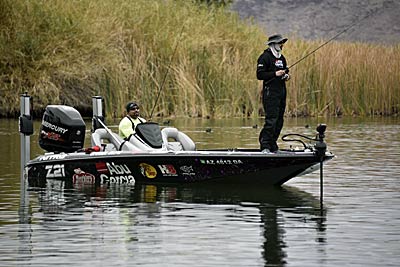
The key to fishing the Free Rig, Daniel says, is the leader length. He uses an 8-pound Trilene 100% fluorocarbon leader. Most of the time, he is used to using a leader no longer than the rod he is fishing with, but with the Free Rig, he ties on twenty to thirty FEET of fluorocarbon leader. Since the fluorocarbon has no stretch, it doesn’t negate the sensitivity of the Nanofil at all. “The fluorocarbon is just so the fish can’t see the line,” he says, “plus it’s smooth, so the weight slips up and down easily.” The leader’s extreme length is necessary because the hook can be far behind the weight. He doesn’t want to risk having a knot rubbed back and forth by the weight of rod guides.
How To Fish The Free Rig
Besides the Jester, Daniel has also had pretty good luck with a Berkley Havoc Bottom Hopper finesse worm. He’ll also Texas rig the worm if he’s fishing around cover, but he says you’d be surprised at how well the little nose-hooked bait will come through cover. However, his bigger fish have come on the Jester. “It’s a small bait,” he says. “It’s only about three inches long, but it’s bulky. It kinda looks like a crawdad.”
He likes this rig on those 45-degree banks, stair-stepped banks, or bluffs. That allows the weight to fall while the bait flutters down. “It’s killer on those stair-steps,” he says. You cast the rig out, let the sinker hit bottom, then give the bait a chance to sink behind it. Patience pays off here, and it pays to have a pool to practice in so you can get a feel for how long it takes different baits to sink. The entire time the rig is down there, the distance between the weight and the lure changes. It’s essential that you have a big bow in your line, says Elias – the fish are going to hang on to the Power Bait if they don’t feel any pressure. Sometimes he starts to reel it in to re-cast, and it just feels mushy. When this happens, he reels as fast as possible to get caught up, then sweeps the rod sideways and lets it load up. This isn’t a case of massive hooksets, not with a finesse hook. Take up the slack and sweep-set.
An Open "Secret"
Elias was excited when he first got on to the Free Rig. He went to the lake and caught fish all over the place, one fish after another. He pulled up to another boat and asked them how they were doing, and the reply was “nada.” The next guy he spoke to had caught one. Elias caught 35 fish that day and couldn’t wait to share them with his team partner. They decided to keep it a secret. Two or three weeks later, his partner called him, really peeved. It turns out a well-known pro had shown the world this rig on video. So much for secrecy. But many people still haven’t heard about it, Elias says, and the ones who have are still trying to figure out its applications. It seems to be a rig that works well whether you fish it shallow or deep. That little Fusion19 hook is so sharp it hooks the fish way better than a Texas rig would say. You might lose a few around cover, and that’s a bummer, but Daniel says that the hook is so good he deals with it.
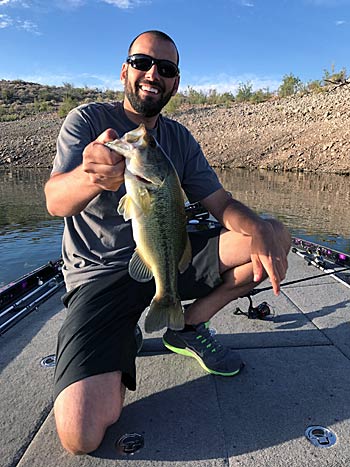
Theoretically, he says, you could fish it with a casting weight, but the cylinder comes through rocks much better. He even fishes it on grass and goes so light that it will stay on top. Another possibility is using it for fishing a stick bait a lot deeper. Elias is still experimenting with this rig for bass, and so far, he loves the results.
You'll need weights if you’d like to try the Free Rig. Here are some places to find them:
Reins TG Slim Drop Shot tungsten weights with a tie-on. They range in size from 1/16-ounce to 3/8-ounce. Depending on size, they come in packs of five, four, three, or two.
Lindy No-Snagg Slip Sinkers are available in sizes from 1/8 to 1 ounce. They come in packages of two for $6.
Hilitchi Raindrop Bullet Streamlined Shape Lead Fishing Weights. These are on Amazon, and the weights are given in grams. 10g is .35 oz or a little over ¼ oz. They go up to approximately ½ oz, ¾ oz, and even 1 ounce and bigger. A package of 10 – 10g weights is $6.99 on Amazon. Search for Hilitchi Raindrop Bullet Weights. As you click on the options, you can look at the photos on the left to see what size and how many per package.
Picasso Tungsten Drop Shot Cylinder. These come in weights from 1/8-ounce to ½-ounce. These have the round line tie.
You can also find various “casting sinkers” at Bass Pro Shops. They have egg-shaped sinkers with tie-on loops starting at 1/8 ounce and Pencil Sinkers(cylinder weights) with tie-on loops starting at ¼-ounce for only $2.99 for 10.
Also, if you search Amazon for “Pencil Sinkers,” you will find many of them from Catch more/Grapentine Specialties with an eye or a swivel. They start at $16.99 for a 25-pack.
BassResource may receive a portion of revenues if you make a purchase using a link above.


